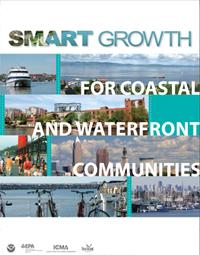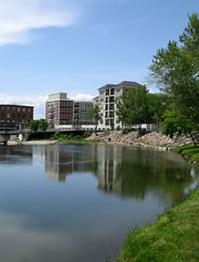Smart Growth for Coastal and Waterfront Communities


Coastal and waterfront communities have a distinctive sense of place created by their history and characteristic sights, sounds, and smells. These communities face many challenges, including potential sea level rise, hurricanes, flooding, other weather and climate-related hazards, vulnerable ecosystems, and limited land. More than half the U.S. population lives in coastal counties covering less than 17 percent of U.S. land area, and 180 million people visit coastal areas every year. Many others visit lake and riverfront communities.
As they struggle to accommodate this intense interest, many of these communities have found that conventional development patterns threaten the assets they treasure most. Smart growth approaches can help accommodate development, protect natural resources, and keep people and property out of harm's way.
Smart Growth for Coastal and Waterfront Communities (2009) builds on the smart growth principles to offer 10 development guidelines for coastal and waterfront communities. Developed in consultation with the Smart Growth Network, these guidelines reflect waterfront communities’ challenges and opportunities.
The publication was developed by EPA in partnership with the National Oceanic and Atmospheric Administration (NOAA), Rhode Island Sea Grant, and the International City/County Management Association. It highlights tools, techniques, and examples of smart growth in practice for planners, local decision-makers, developers, nonprofit groups, and others interested in waterfront development issues.
Smart Growth for Coastal and Waterfront Communities is available for download through the NOAA website on Coastal and Waterfront Smart Growth, which features supplemental information that is updated periodically.
For print copies, email nscep@lmsolas.com or call (800) 490-9198 and request EPA 231-K-09-001.
Learn more about smart growth and water issues.
|
Smart Growth Principles |
Smart Growth Coastal and Waterfront Elements |
|---|---|
| 1. Mix land uses. | 1. Mix land uses, including water-dependent uses. |
| 2. Take advantage of compact building design. | 2. Take advantage of compact community design that enhances, preserves, and provides access to waterfront resources. |
| 3. Create a range of housing opportunities and choices. | 3. Provide a range of housing opportunities and choices to meet the needs of both seasonal and permanent residents. |
| 4. Create walkable communities. | 4. Create walkable communities with physical and visual access to and along the waterfront for public use. |
| 5. Foster distinctive, attractive communities with a strong sense of place. | 5. Foster distinctive, attractive communities with a strong sense of place that capitalizes on the waterfront's heritage. |
| 6. Preserve open space, farmland, natural beauty, and critical environmental areas. | 6. Preserve open space, farmland, natural beauty, and the critical environmental areas that characterize and support coastal and waterfront communities. |
| 7. Strengthen and direct development toward existing communities. | 7. Strengthen and direct development toward existing communities and encourage waterfront revitalization. |
| 8. Provide a variety of transportation options. | 8. Provide a variety of land- and water-based transportation options. |
| 9. Make development decisions predictable, fair, and cost effective. | 9. Make development decisions predictable, fair, and cost effective through consistent policies and coordinated permitting processes. |
| 10. Encourage community and stakeholder collaboration in development decisions. | 10. Encourage community and stakeholder collaboration in development decisions, ensuring that public interests in and rights of access to the waterfront and coastal waters are upheld. |
